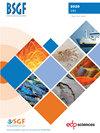The Alboran domain in the western Mediterranean evolution: the birth of a concept
IF 2.6
3区 地球科学
Q2 GEOSCIENCES, MULTIDISCIPLINARY
引用次数: 34
Abstract
Since the early 70’s the majority of tectonic reconstructions of the western Mediterranean employ the Alboran domain notion as a migrating microcontinent or landmass mainly composed of Paleozoic-Triassic rocks affected by ‘Alpine’ HP-LT metamorphism. For nearly three decades, since the mid-80’s, the Alboran domain was considered as a fragment of the Alpine chain that moved westward, colliding into Iberia and North Africa to produce the Gibraltar arc and Betic-Rif chain. In 2012, a new hypothesis for the evolution of the western Mediterranean was presented in which the Betic-Rif orogenic chain originates from rollback of an initially SE-dipping subduction of the westernmost segments of the Ligurian-Tethys under the Africa margin. This interpretation considers the metamorphic ‘Alboran domain’ rocks as crustal successions of the hyper-extended African and Iberian continental margins, which have undergone a complete subduction-exhumation cycle above a NW- to W-retreating subduction. A key outcome of this hypothesis is that the Alboran domain is not a fragment of the Alpine chain but a consequence of rollback dynamics. In this contribution we try to elucidate the historical reasons behind the classical ‘Alpine’ interpretation of the Betic-Rif, by briefly describing key contributions, which appear linked in a logical sequence that traces the evolution of the Alboran domain concept since its original formulation by Andrieux and coauthors in 1971.地中海西部地区的演变:一个概念的诞生
自20世纪70年代初以来,西地中海的大部分构造重建都采用了Alboran域的概念,认为它是一个迁移的微大陆或陆块,主要由受“高山”高温-低温变质作用影响的古生代-三叠纪岩石组成。自80年代中期以来的近30年里,阿尔博拉域被认为是向西移动的阿尔卑斯链的一个片段,与伊比利亚和北非碰撞,形成了直布罗陀弧和贝提-裂谷链。2012年,提出了西地中海演化的新假说,认为贝提-裂谷造山链起源于利古里亚-特提斯构造最西段在非洲边缘的初始东南倾俯冲回退。这种解释认为,变质的“阿尔博拉域”岩石是超伸展的非洲和伊比利亚大陆边缘的地壳序列,在北西向西后退的俯冲作用上经历了一个完整的俯冲-出露循环。这一假设的一个关键结果是,Alboran域不是Alpine链的片段,而是回滚动力学的结果。在这篇文章中,我们试图通过简要描述关键贡献来阐明贝特里夫经典“阿尔卑斯”解释背后的历史原因,这些贡献似乎以逻辑顺序联系在一起,追溯了自1971年安德里厄及其合作者最初提出阿尔博朗域概念以来的演变。
本文章由计算机程序翻译,如有差异,请以英文原文为准。
求助全文
约1分钟内获得全文
求助全文
来源期刊
CiteScore
5.80
自引率
0.00%
发文量
18
审稿时长
>12 weeks
期刊介绍:
BSGF - Earth Sciences Bulletin publie plusieurs types de contributions :
1. des articles originaux, couvrant tous les champs disciplinaires des Géosciences, à vocation fondamentale mais également à vocation plus appliquée (risques, ressources);
2. des articles de synthèse, faisant le point sur les avancées dans un domaine spécifique des Géosciences, qu''elles soient méthodologiques ou régionales ;
3. des monographies sur la géologie d’une région donnée, assorties d’informations supplémentaires, cartes, coupes, logs, profils sismiques … publiées en ligne en annexe de l’article ;
4. des articles courts de type « express letter » ;
5. des livrets-guides d’excursion (qui suivront le même processus d’examen éditorial que les articles plus classiques) ;
6. des comptes rendus de campagnes à la mer ;
7. des articles de données géodésiques, géophysiques ou géochimiques, pouvant devenir des articles de référence pouvant conduire à des interprétations ultérieures.
BSGF - Earth Sciences Bulletin constitue également un forum pour les discussions entre spécialistes des Sciences de la Terre, de type comment-reply ou autre. Tous les articles publiés, quelle que soit leur forme, seront accessibles sans frais (articles en Open Access) sur le site de la SGF et sur celui de Geosciences World dans la mesure où les auteurs se seront acquittés d’une contribution de (Article Processing Charges – APC) de 300€ pour les membres de la SGF et 500€ pour les non-membres.

 求助内容:
求助内容: 应助结果提醒方式:
应助结果提醒方式:


